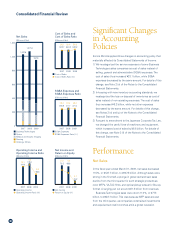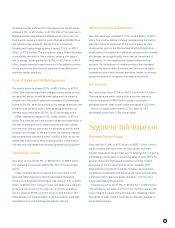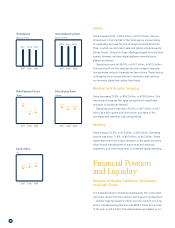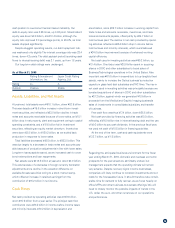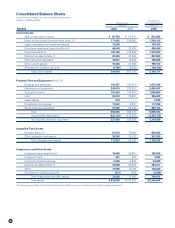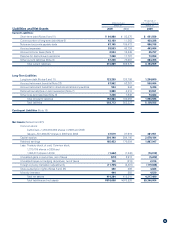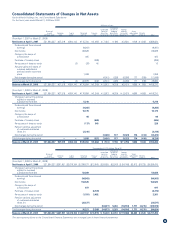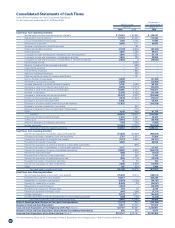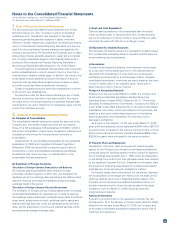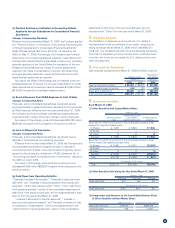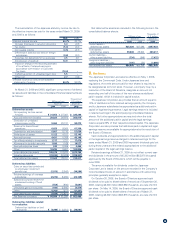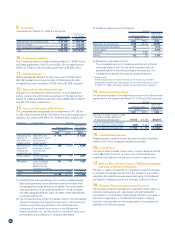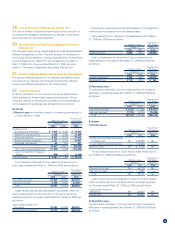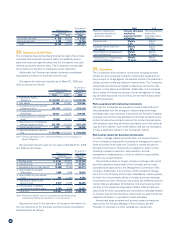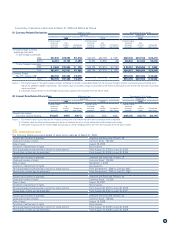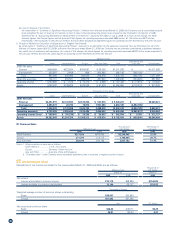Konica Minolta 2009 Annual Report Download - page 36
Download and view the complete annual report
Please find page 36 of the 2009 Konica Minolta annual report below. You can navigate through the pages in the report by either clicking on the pages listed below, or by using the keyword search tool below to find specific information within the annual report.
34
As a result of this change, operating income and income before
income taxes and minority interests decreased ¥6,587 million
($67,057 thousand) from the prior year when compared with the
previous method.
(g) Goodwill or Negative Goodwill
Goodwill recognized by the Companies including foreign
subsidiaries is amortized on a straight-line basis over a period not
exceeding 20 years.
(h) Income Taxes
Deferred income taxes are recognized based on temporary
differences between the tax basis of assets and liabilities and
those as reported in the consolidated financial statements.
(i) Research and Development Costs
Research and development costs are expensed as incurred.
(j) Financial Instruments
Derivatives
All derivatives are stated at fair market value, with changes in fair
market value included in net income for the period in which they
arise, except for derivatives that are designated as “hedging
instruments” (see Hedge Accounting below).
Securities
Investments by the Companies in equity securities issued by
unconsolidated subsidiaries and affiliates are accounted for using
the equity method; however, investments in certain unconsoli dated
subsidiaries and affiliates are stated at cost because the effect of
application of the equity method would be immaterial.
Other securities for which market quotations are available are
stated at fair market value. Net unrealized gains or losses on these
securities are reported, net of tax, as a separate component of
net assets.
Other securities for which market quotations are unavailable are
stated at cost, except in cases where the fair market value of equity
securities issued by unconsolidated subsidiaries and affiliates or
other securities has declined significantly and such impairment of
value is deemed other than temporary. In these instances, securi-
ties are written down to the fair market value and the resulting
losses are charged to income during the period.
Hedge Accounting
Gains or losses arising from changes in fair market value of
derivatives designated as “hedging instruments” are deferred as
an asset or a liability and charged or credited to income in the
same period that the gains and losses on the hedged items or
transactions are recognized.
Derivatives designated as hedging instruments by the
Companies are principally interest rate swaps, and forward foreign
currency exchange contracts. The related hedged items are trade
accounts receivable and payable, long-term bank loans and debt
securities issued by the Companies.
The Companies have a policy to utilize the above hedging instru-
ments in order to reduce the Companies’ exposure to the risk of
interest rate and exchange rate fluctuations. As such, the
Companies’ purchases of the hedging instruments are limited to,
at maximum, the amounts of the hedged items.
The Companies evaluate the effectiveness of their hedging
activities by reference to the accumulated gains or losses on the
hedging instruments and the related hedged items from the
commence ment of the hedges.
(k) Leases (as a lessee)
Changes in Accounting Standards
Previously, lease payments under finance leases that do not trans-
fer ownership of the leased property to the lessee were recognized
as an expense. Effective from the year ended March 31, 2009, the
Company and its domestic consolidated subsidiaries adopted ASBJ
Statement No. 13, “Accounting Standard for Lease Transaction”,
and ASBJ Guideline No. 16, “Guidance on Accounting Standard for
Lease Transaction”, originally issued by the Business Accounting
Deliberation Council on June 17, 1993 and the Japanese Institute of
Certified Public Accountants on January 18, 1994, respectively, and
both revised by the ASBJ on March 30, 2007. Consequently, lease
assets are recognized as a normal sales transaction. This adoption
had no impact on the consolidated statements of income.
Upon adoption, lease payments under finance leases, previously
accounted for in the “Cash flows from operating activities” section
of the consolidated statement of cash flows, are now accounted
for in the “Cash flows from financing activities” section. The effect
of this change was not material to the consolidated statement of
cash flows.
(l) Retirement Benefit Plans
Retirement Benefits for Employees
The Company, domestic consolidated subsidiaries and certain over-
seas consolidated subsidiaries have obligations to make defined
benefit retirement payments to their employees and, therefore, pro-
vide accrued retirement benefits based on the estimated amount of
projected benefit obligations and the fair value of plan assets.
For the Company and its domestic consolidated subsidiaries,
unrecognized prior service cost is amortized by the straight-line
method over a 10-year period, which is shorter than the average
remaining years of service of the eligible employees. Unrecognized
net actuarial gain or loss is primarily amortized from the following
year by the straight-line method over a 10-year period, which is shorter
than the average remaining years of service of the eligible employees.
Accrued Retirement Benefits for Directors and Statutory Auditors
Domestic consolidated subsidiaries record a reserve for retirement
benefits for directors and statutory auditors based on the amount
payable accumulated at the end of the period based on the
internal regulations.
(m) Per Share Data
Net income per share of common stock has been computed based
on the weighted-average number of shares outstanding during
the year.
Cash dividends per share shown for each year in the accompany-
ing consolidated statements are dividends declared as applicable to
the respective year.


